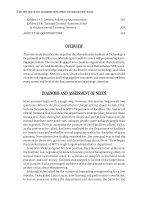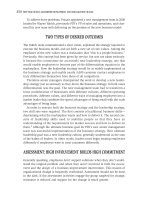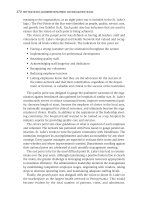Tài liệu Best Practives in Leadership Development & Organization Change 46 ppt
Bạn đang xem bản rút gọn của tài liệu. Xem và tải ngay bản đầy đủ của tài liệu tại đây (137.24 KB, 10 trang )
that customers, shareholders, and employees can count on. To do that, all
employees must
1. Be accountable for achieving results
2. Act with speed in meeting customer requirements
3. Behave consistently with a shared mindset resulting in believability
to the customer
4. Collaborate and learn together to drive out redundancy
5. Develop and share talents so that StorageTek is a great place for highly
skilled employees to spend their careers
The right balance also means remaining a company focused on its employ-
ees and maintaining a culture where employees feel valued and respected,
believe their work provides meaning, and can achieve work-life balance.
STORAGETEK: THE HIGH-PERFORMANCE ORGANIZATION
During 2001 and 2002, the United States and much of the world was in an eco-
nomic slump. Information technology spending was down significantly and the
price of data storage technology was eroding. Through the first half of 2002,
revenue was flat and market share was static at best.
Then third quarter 2002 results indicated a glimmer of hope that StorageTek
might have made the turn after all. Reported results included a slight growth in
revenue, an increase in market share, and double-digit growth in services. With
a pipeline of orders for fourth quarter, new products introduced, and a slight hint
of optimism, perhaps StorageTek had begun to achieve the real and lasting results
desired. The fourth quarter and 2002 full year financial results were very posi-
tive. “This was our best quarter for revenue in the past two years and has resulted
in StorageTek gaining market share in tape, disk, networking and storage
services,” said Pat Martin, chairman, president, and chief executive officer.
Results for 2003 continued to show success with revenue growth and strong earn-
ings. The “cadence of change” delivered the desired results of a high-performance
organization. The challenge ahead is to stay the course in maintaining the
balance between traditional operational management and innovation.
As a high-performance organization, StorageTek wants to be respected in the
communities in which its employees work and live, recognized by people who
want to do business with it, selected as an employer of choice, and known for
operating guidelines including integrity and core values. Achieving these goals
will mean that StorageTek will enjoy a perceived value evidenced by stock price
and an increase in highly talented employees. Total shareholder return should
increase as a result.
420
BEST PRACTICES IN LEADERSHIP DEVELOPMENT AND ORGANIZATION CHANGE
cart_14399_ch17.qxd 10/19/04 1:18 PM Page 420
STORAGETEK
421
Transformation Phase Lessons Learned
Define the challenge
Work through change
Attain and sustain
improvement
Define where the company is going—provide
the result of the program with measurement that
translates into business objectives
Use as much as possible of what already exists
in the organization
Develop a cadence of change to maintain
employee awareness
Focus actions on individualized requirements
on three levels
Hold all employees accountable for
achieving results
Assess organizational readiness for change
and stay flexible
Take the 80 percent solution
Maintain the cadence of change
Stay the course
Adjust and improve as needed
Exhibit 17.1. Summary of Lessons Learned
cart_14399_ch17.qxd 10/19/04 1:18 PM Page 421
REFERENCES
Foster, R., and Kaplan, S. Creative Destruction. New York: Doubleday, 2001, p. 90.
Ulrich, D., Zenger, J., and Smallwood, N. Results-Based Leadership. Cambridge, Mass.:
Harvard Business School Press, 1999.
“War for Talent.” The McKinsey Quarterly, 1998, Number 3.
“The War for Talent 2000.” The McKinsey Quarterly, July 2001.
ABOUT THE CONTRIBUTOR
Susan Curtis is StorageTek’s leadership coach. Curtis joined StorageTek in 1998.
In her former role as director of leadership and change management, she was
responsible for leadership development, including succession planning, employee
communications, professional development, training, and change management.
Before joining StorageTek, Curtis held several organizational development,
leadership development, and training management positions with Johns
Manville, Rockwell International, and EG&G. She taught at the community
college level for a number of years in Florida and designed the curriculum for the
Community College of Aurora (Colorado) at its founding. Curtis is a founder of
Women’sLink, an intercorporate leadership development and networking
program that links midlevel corporate women with senior-level women. Curtis
also contributed expertise to the design of Web-based culture assessment and
career development tools. These tools and Women’s Link are currently available
to members of the Women’s Vision Foundation. Finally, she was a member of
the Goodwill Industries of Denver board of directors for six years, including one
year as chair. Curtis earned bachelor’s and master’s degrees from Iowa State
University and a Ph.D. in curriculum and instruction, post-secondary education
from the University of Florida.
422
BEST PRACTICES IN LEADERSHIP DEVELOPMENT AND ORGANIZATION CHANGE
cart_14399_ch17.qxd 10/19/04 1:18 PM Page 422
CHAPTER EIGHTEEN
Windber Medical Center
A patient-centered care model for creating a healing environment that leads
to shorter lengths of stay, lower infection rates, and reduced mortality rates
through a healing culture that embraces mind, body and spirit.
OVERVIEW 424
INTRODUCTION: PATIENT EMPOWERMENT 425
DIAGNOSIS: THE DECISION TO CHANGE 425
ORGANIZATIONAL CHALLENGE 426
Reasons for Change 427
Change Objectives 427
APPROACH 428
ASSESSMENT: THE MAN SHOW 428
Physicians 429
Employees 430
FEEDBACK USE 430
DESIGN: PLANETREE PHILOSOPHY 431
INTERVENTION: FUNDAMENTAL CHANGES 431
THE PLANETREE TEAMS 432
LOOKING BACK 432
The Change Circle 433
It Gets Worse Before It Gets Better 433
I’m from the Government and I’m Here to Help 434
Getting Back on Track 434
Quantifying the Results: Exhibits 435
Exhibit 18.1: Average Length of Stay 435
Exhibit 18.2: Nosocomial Infection Rate 436
423
S
S
cart_14399_ch18.qxd 10/19/04 1:20 PM Page 423
Exhibit 18.3: Mortality Comparison by Hospital 436
Moving Ahead Again 437
LESSONS LEARNED 437
ABOUT THE CONTRIBUTOR 438
OVERVIEW
This change management case study explores and details the transition of a
small, urban hospital from a traditional, acute care facility to a Planetree hos-
pital. Plantree hospitals are accredited by the Planetree organization, whose mis-
sion is “to serve as a catalyst in the development and implementation of new
models of health care, which cultivate the healing of mind, body, and spirit; are
patient-centered, value-based, and holistic; and integrate the best of Western
scientific medicine with time-honored healing practices” (from Planetree
website: www.planetree.org).
The philosophy of Windber Medical Center was developed and nurtured in
the Industrial Revolution. The change from this paternalistic, parent-to-child
environment to one in which patients have choice and participate in their care
in surroundings that embrace holistic, patient-centered care is not new, but it
is revolutionary.
This little hospital, located just a few miles from the site where United
Flight 93 went down on September 11 and less than ten miles from the Quecreek
mine where the nine coal miners were rescued is nearly one hundred years old.
Windber Hospital was started by a coal mining company, the Berwind White
Coal Company, to take care of its workers. When Western Pennsylvania coal
went out of style due to high pollution levels, the hospital and the town also fell
out of favor.
Under the leadership of a new president, the organization took on the chal-
lenge of recreating itself by enlisting physicians and employees to return as
patient advocates and also returning to the caring, nurturing roots of health care.
Using already existing care models and the power of love, the organization
began a change journey that would forever alter its culture into a unified
approach that makes patient-centered care its top priority. The hospital, which
has gone on to gain national attention, has created a research institute and gar-
nered over $30 million in grants during the past four years. Because of Plane-
tree, it has established itself as a prime example of a model hospital for the
future.
The lessons learned by the Windber Medical Center are important for
any organization undergoing a major change initiative in which success of the
entire organization depends on the outcome of the effort.
424
BEST PRACTICES IN LEADERSHIP DEVELOPMENT AND ORGANIZATION CHANGE
cart_14399_ch18.qxd 10/19/04 1:20 PM Page 424









